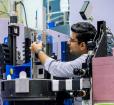

Showing 1981 - 2000 of 2566 results


Australian Centre for Neutron Scattering Publications
Scientists and researchers within ANSTO's Australian Centre for Neutron Scattering area have been published in a wide range of publications and have presented at many conferences.

Investigating isotopes
Learn about isotopes using real examples and real data, including comprehensive isotopic data of the first twenty chemical elements in the periodic table (hydrogen to calcium). Teachers can use the accompanying worksheet, in sections or in its entirety, to develop student skills in literacy, numeracy, critical and creative thinking and ICT. These activities are suitable for students in Years 9 to 12.
Students will:
- learn how the number of neutrons and protons in an isotope affects its nuclear properties
- construct a section of the Table of isotopes, using MS Excel
- investigate the properties and uses of different isotopes
Synroc: Australian innovation increases technology readiness for waste treatment plant
Discovery of Australia's oldest pottery rewrites understanding of Aboriginal marine history
In a paper published yesterday, Traditional Owners and researchers report on the oldest securely dated pottery discovered in Australia, located at Jiigurru (Lizard Island Group) on the Great Barrier Reef.
Collaboration publishes landmark blue carbon study
ANSTO environmental scientists contribute to investigation of carbon capture in wetlands.
International award recognises achievement
ANSTO's reactor utilisation team has received an international award.
Promising new proton conductor for next-generation fuel cells
ANSTO has contributed to work by scientists from the Tokyo Institute of Technology on a promising proton conductor for next-generation ceramic fuel cells.
Proposed new ANSTO waste facility
The independent nuclear regulator, ARPANSA, is currently accepting submissions about ANSTO’s planned $59.8 million Intermediate Level Solid Waste Storage Facility.
ANSTO’s advanced radiation imaging solution CORIS360® - wins two Gold Good Design Awards
ANSTO’s CORIS360®, an advanced radiation imaging solution, has been awarded two Gold Good Design Awards from Good Design Australia, winning in the categories of Product Design/ Commercial and Industrial as well as Engineering Design.
Diabetes Awareness Week: The importance of insulin
Communicating the role of nuclear science for the IAEA’s Sustainable Development Goals
In cooperation with ANSTO and for the third year running, the IAEA has recently hosted a two-week online training course for women professionals working in numerous nuclear industries around the world, titled 'Women 4 Nuclear Science in Education and Communications'.

Deuterated mineral oil enables polymer research
The National Deuteration Facility has supported industry through the synthesis of deuterated mineral oil, which was supplied to Japanese chemical manufacturer Mitsui Chemicals. Mitsui Chemicals specialises in polymeric materials for packaging, appliances, construction and other applications.
Sharing expertise with Japan
The National Deuteration facility is assisting with the establishment of a Japanese Chemical Deuteration Facility.
Nuclear techniques bring new insights into food
Research explores how structure contributes to function in food
Australian Synchrotron to join consortium mapping the human brain
Consortium will map the 86 billion nerve cells, 100 trillion connections and neurotransmitters in the human brain.

Technical information - Kookaburra
Specifications, Instrument layout, and Instrument reference

User Meeting 2024 Accommodation Options
Accommodation Information
Early career researchers feature in Careers with Science publication

Meet an Expert
Let your students lead a 30-minute Q&A session with our ANSTO experts about one of the following three topics:
- Nuclear medicines
- Nuclear techniques to study the environment
- Fission and its applications in reactors
Our staff are experienced science communicators and can discuss ANSTO's research with secondary classes at an appropriate level of detail.
Please ensure your students do some pre-reading about the research topic and come prepared with questions to ask during the session. We also ask that teachers send us a copy of the student questions the day before, so we can adequately prepare for your session.
Teachers must be present during the session with their students.
Cost: Free